MACHINE ENGRAVER – One who performs the set-up of an engraving
machine after which the machine cuts, mills, or scratches the object
either by electric or manual power.
|
MACHINE ENGRAVING – Cutting or scratching done into the surface
of an object by an electrically or manually powered machine (usually a
pantograph) which is either manually set-up or set-up and controlled by
a computer. Engraving machines create their lettering, decoration, or
embossing by contacting the surface of the object with a diamond
stylus, rotary milling cutter, laser, or cutting bit.
|
MAGNABLOCK™ – A large and heavy block manufactured by GRS
weighing 30 lbs. (13.7kg). Many engravers use the term magnablock as a
generic term for any large and heavy block.
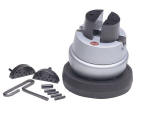
|
MAGNAGRAVER® – The Magnagraver® is a freehand engraving tool
that is powered by an electric motor and flex-shaft cable. There are
five components required to engrave with a Magnagraver®, the
Magnagraver® hand piece, a graver, foot pedal, electric motor and
flex-shaft. Compared to the various air powered freehand engraving
tools, the Magnagraver operates at the slowest speeds (60-1800 impacts
per minute) which combined with its mechanics causes its cuts to look
more like those of hammer and chisel engraving. Tool designer and
engraver Ray Phillips of Bozrah, Connecticut, invented the Magnagraver
that is manufactured and sold by the NgraveR® Company. Many engravers
also refer to the Magnagraver® as the “n-grave-r.”
The Magnagraver® is not an “engraving machine” in the sense that it is
completely controlled free hand by the engraver. Its main advantage
over hammer & chisel is that the hammer within the hand piece takes the
place of a chasing hammer thus freeing one of the engraver’s hands to
turn the engraving block as well as greater control of the graver than
can be supplied by manual power alone.
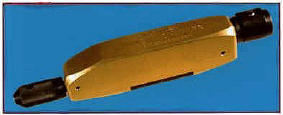
|
MARTELLO – Italian for hammer. As used by Italian engravers, a
martello is a chasing hammer.
|
MASCHERONE – Italian for mask. As used by engravers, macherone
refers to a grotesque or grotesque mask.
|
MASTER ENGRAVER – In the United States, the Firearms Engravers
Guild of America has in place a process to certify highly skilled gun
engravers and bestow the title of FEGA Master Engraver. To achieve this
certification, a member engraver must submit an application, meet
certain requirements (such as having a federal firearms license), and
submit sample work to a jury of previously certified masters. At
present there are approximately 41 FEGA Certified Masters in the United
States. FEGA Certified Masters are authorized to use an official seal
to designate their status.
It should be noted that all FEGA members are not certified masters
however there are members who engrave at the highest levels of the art
who, for personal reasons, have not chosen to go through the process of
becoming certified.
Also in the US, the Colt Firearms Co. certifies certain gun engravers
as “Colt Master Engraver.” The fact that an engraver works in the Colt
factory does not automatically qualify the engraver as a Colt Master.
This designation is bestowed by the head of the Colt Custom Shop on
those deemed qualified. A very few freelance engravers are designated
as Colt Master Engravers by virtue of their selection to engrave the
annual Colt Collectors Assn. show gun which is inevitably a very ornate
museum quality show piece.
A small number of other engravers working in the United States carry an
official designation of Master Engraver by virtue of having received
that designation from a sanctioning agency in another country such as
Austria, Belgium, France, or Germany. All other gun engravers in North
America who use the title “Master Engraver” are using a self-bestowed
title.
In the jewelry and die making trades there are no guilds to certify
master engravers however some jewelry or die engravers may have
received such a designation from their employer.
Outside the United States, particularly in Europe, there are formal
schools, trade guilds, or official governmental bodies who are
authorized to bestow the title of Master Engraver on those who have met
strict guidelines and passed written and skill tests as well as
sufficient longevity in the trade.
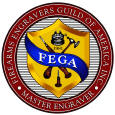
Pictured is the FEGA Master seal which is only authorized for use by
FEGA certified master gun engravers.
|
MATT/MATTING – The process of imparting a texture to metal. A
matt background is usually done with a matting punch that has a texture
embossed on the tip. Matting can also be done with a liner. Matting and
stippling are very similar in appearance.
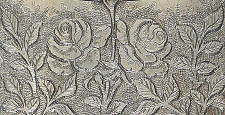
Pictured is a rose floral engraving whose background has been textured
with a matting punch.
|
McGRAW SCROLL – The late gun engraver, Bill McGraw was a long
time employee of the Ithaca Gun Co. who developed a distinctive style
of ornamental scrollwork that is immediately identifiable on any of the
hundreds of guns he engraved. McGraw scroll incorporates few spirals
with large, puffy leaves, all shaded with a liner. Unlike other gun
scroll styles named after a particular engraver such as Nimschke or
McKenzie, McGraw’s style has not been widely copied.
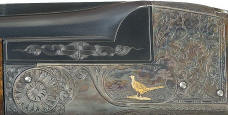

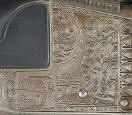
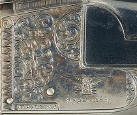
Shown here are four examples of the unique McGraw scroll engraved into
a variety of Ithaca shotguns.
|
McKENZIE SCROLL – A distinctive style of scrollwork popularized
by the late Lynton S. M. McKenzie who was an internationally renowned
gun engraver born in Australia. McKenzie immigrated to the USA after
working in England. During the 1980’s numerous gun engravers copied
McKenzie’s style of scroll because of its clean and simple look.

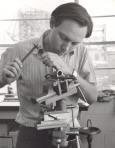
Pictured is an example of McKenzie scroll and McKenzie engraving with
hammer & chisel.
|
MEISEL – German: Chisel
|
MICROSCOPE – Many present day hand engravers utilize a
microscope while engraving. Some use the “scope” for all engraving and
others only use it for fine detail work. The microscope is not a
necessity for hand engraving but a helpful aid for those who were
initially trained on it or adapted to its use. Even today, many of the
world’s top engravers rely on the loupe or Optivisor for close work.
As used by hand engravers, the preferred microscope is of the binocular
type with relatively low power magnification so that the focal distance
allows clearance for the engravers hand and graver.
http://www.handgravers.com/microscopes.htm
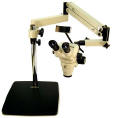
|
MILGRAIN – A decorative technique in which a beaded design is
impressed into metal using a wheel or stylus with hemispherical
depressions.
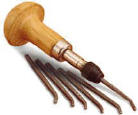

Pictured is a milgrain tool with additional points for different size
beads and a milgrain wheel showing the depressions.
|
MODERN ART ENGRAVING - The term modern art is usually associated
with art in which the traditions of the past have been thrown aside in
a spirit of experimentation. A tendency toward abstraction is
characteristic of much modern art. Engraving in this style is usually
found on craft jewelry rather than fine jewelry. Among gun engravers
and their patrons, modern art has found little acceptance or interest
other than in France where it has been experimented with on a limited
basis. Modern art engraving is also rarely found on custom made knives.
|
MONOGRAM – A motif made by overlapping or combining two or more
letters or other graphemes to form one symbol. Monograms are often made
by combining the initials of an individual or a company, used as
recognizable symbols or logos. A series of uncombined initials is
properly referred to as a cipher and is not a monogram, although
ciphers are frequently referred to as monograms.
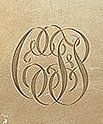
|
MORSA da BANCO – Italian for a bench mounted engraver’s vise.
|
MORSA da TAVOLO – Italian: Literally, vise of the table. An
engraver’s block.
|
MOTIF – A decorative design, such as an eagle and shield, police
badge, griffin, grotesque, Masonic emblem, or a crown.
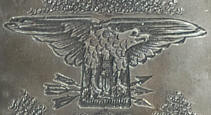
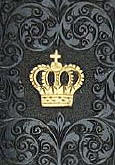

Pictured are examples of engraved motifs, an eagle, crown, and shell.
|
MOTORCYCLE ENGRAVING – Some hand engravers specialize in the
engraving of custom motorcycle parts and accessories. Nearly any metal
component of a motorcycle can be engraved. Those engravers specializing
in the motorcycle field have developed special work holding fixtures
and procedures to accommodate the large and unusual configuration of
engine and running gear parts. Accordingly, motorcycle engravers have
also had to adapt their ornamental designs to their specialty.
Motorcycle and custom car engraving are two of the newest branches of
the engraver’s trade. Initially, most of the decorative designs were
adapted from the field of gun engraving but on a larger scale. While
this is still the case, some engravers have incorporated other
decorative themes such as those found prevalent in “biker” tattoos and
“fantasy” art.
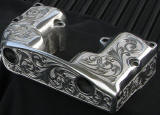
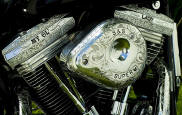
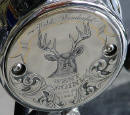
Pictured is an "old school" engraved rocker cover for a 1968 "Iron
Head" Harley Davidson engraved in relief scroll with a bead punched
background by Chris Malouf of West Virginia. Also shown is an
engine and timing cover engraved by Malouf.
|
MUSICAL INSTRUMENT ENGRAVING – The metal parts of various
musical instruments have been the subject of the engraver’s trade for
many years. Engraving is most prevalent on brass instruments such as
saxophones, trombones, and trumpets. The metal parts of stringed
instruments, such as tailpieces and pick guards of guitars and
mandolins is becoming more common however, the banjo has for many years
been the subject of decorative engraving.
Today, there are very few engravers who specialize in only engraving
musical instruments. At one time every manufacturer of brass
instruments had a small staff of hand engravers for higher grades of
their products. Arms or jewelry engravers do most musical instrument
engraving done today.
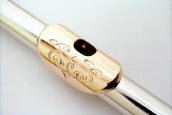
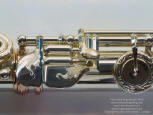
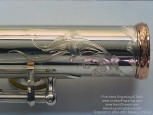
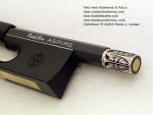
Pictured are examples of flutes and a violin bow engraved by Steve Lindsay.
|